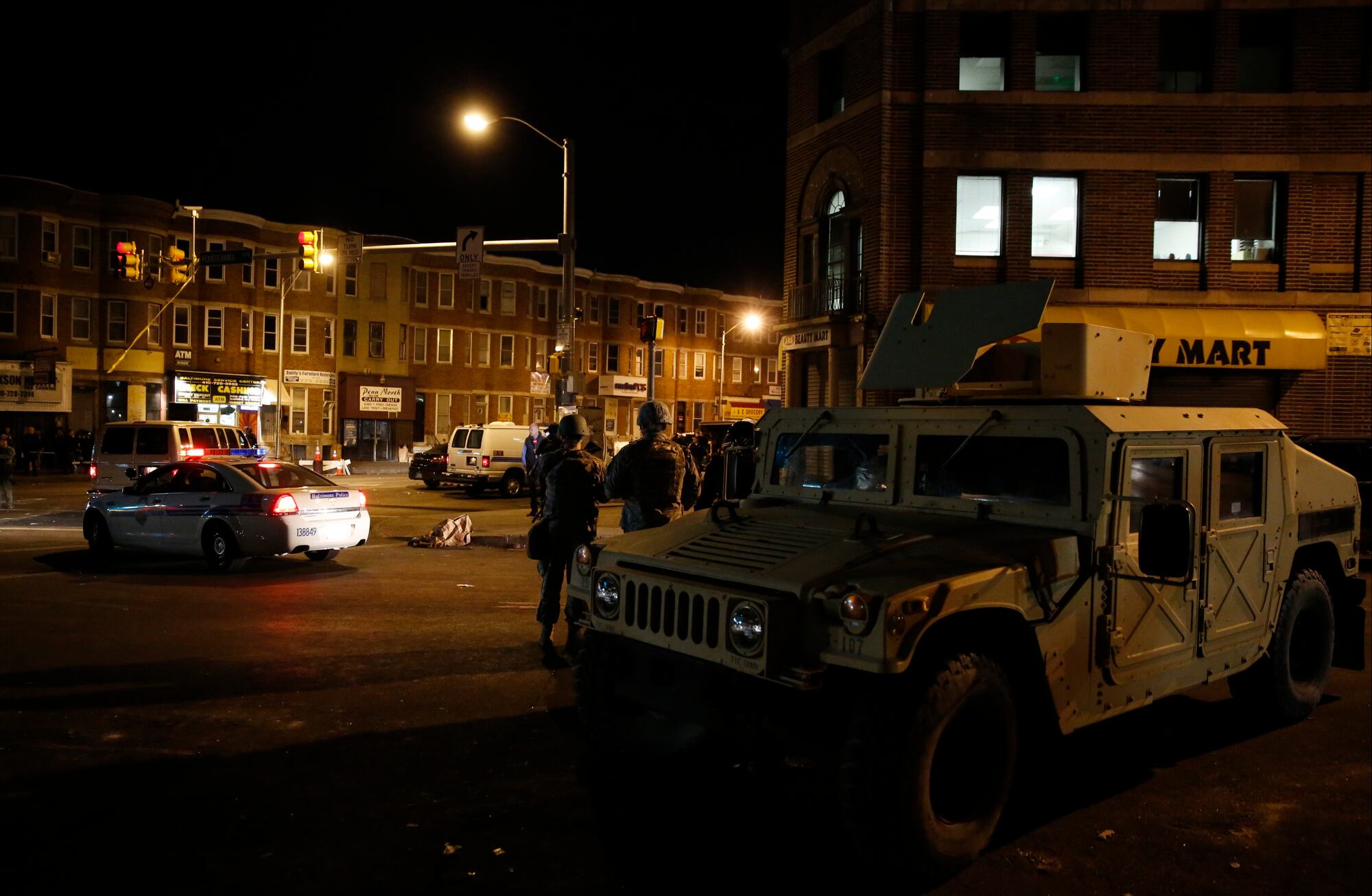BALTIMORE, Md. — The Maryland National Guard backed up state and city police here on Tuesday, and the city seemed to have been spared violence and destruction, at least as of early Wednesday morning.
Most of the Guard mission consisted of providing security to areas — either before trouble started, or after agitators had been cleared by police. Maj. John McDaniel, who commanded 1st Battalion, 175th Infantry Regiment at the scene, told Army Times via text after 1 a.m. that he had not been asked to send Guard soldiers to address any disturbances.
"The message that our soldiers understand is that we're here in support of the civilian authorities, to help them conduct their mission to restore law and order, and to turn this mission back over to the civilian authorities as quickly as possible," McDaniel said hours before the curfew.
At 10:15 p.m. police used smoke and pepper balls to clear dozens of angry protesters — some throwing items at police — from the intersection of Pennsylvania Avenue and North Avenue. Later, more than a dozen National Guard Humvees brought reinforcements to the surrounding blocks, where a CVS Pharmacy was looted and burned by rioters Monday.
Soldiers at the flash point had rifles and full combat gear like those at Inner Harbor and other protected sites, but their rifles did not have magazines loaded into them. By the time Army Times returned to the intersection after it had been cleared, virtually everyone present was either law enforcement, National Guard or media.
The only new signs of the disturbance appeared to be several trash cans emptied and thrown into the street by protesters after being forced to move.
McDaniel said before nightfall that the Guard took lessons from Ferguson, Missouri, where riots generated criticism for a too-militarized show of force that escalated tensions rather than create security. Congressman Elijah Cummings, whose Maryland district includes much of Baltimore, also expressed to concern for the military presence.
"It doesn't make me feel very good, but I realize that we have to keep functioning, and people have to be safe," Cummings said.
It was the first time since the assassination of the Rev. Martin Luther King Jr. in 1968 that the National Guard was called out in Baltimore to quell unrest.
The racially charged violence on Monday was set off by the case of Freddie Gray, a 25-year-old black man who died of a spinal-cord injury under mysterious circumstances while in police custody.

Soldiers from the Maryland National Guard's 200th Military Police Company stand guard and enforce a curfew at the location of earlier rioting in Baltimore, Md., on Wednesday.
Photo Credit: Mike Morones/Staff
Hundreds had gathered in front of the CVS by 9 p.m. Tuesday, including a line of people linking arms to create a barrier in front of a line of police in riot gear.
Urges to go home, including from Cummings, convinced the majority to leave the intersection before curfew. But some angry demonstrators remained, despite warnings from a police helicopter. Eventually, about 15 minutes after curfew, police began moving forward as a line to clear the intersection. Smoke grenades later were deployed, pushing most of what remained back, and pepper balls were also deployed, according to police.
Shortly before the curfew and in a different neighborhood, police arrested three to four juveniles in South Baltimore after people started attacking officers with rocks and bricks, authorities said. At least one officer was reported injured.
Monday's outbreak of looting, arson and rock- and bottle-throwing by mostly black rioters erupted just hours after Gray's funeral. It was the worst such violence in the U.S. since the unrest last year over the death of Michael Brown, the unarmed black 18-year-old shot by a white police officer in Ferguson.
In Baltimore on Tuesday all public schools were closed. The Baltimore Orioles canceled Tuesday night's game at Camden Yards and — in what may be a first in baseball's 145-year history — announced that Wednesday's game will be closed to the public.
The streets were largely calm all day and into the evening, with only a few scattered arrests.
Under the command of the state police, the Guard had spent the day setting up perimeters protecting key city buildings, such as City Hall and prominent areas like Inner Harbor and Johns Hopkins Hospital.
Throughout the day the presence of the Guard turned heads. Downtown had signs of normalcy, but Inner Harbor remained closed and locals marveled at the military presence and the quiet keeping many from venturing out.
"I've never seen it this quiet. It's eerie," said Max Connors, a resident of the Federal Hill neighborhood who was biking near the Harbor.
At the White House, President Barack Obama called the deaths of several black men around the country at the hands of police "a slow-rolling crisis." But he added that there was "no excuse" for the violence in Baltimore, and said the rioters should be treated as criminals.
"They aren't protesting. They aren't making a statement. They're stealing," Obama said.
Jascy Jones of Baltimore said the sight of National Guardsmen on the street gave her a "very eerie feeling."
"It brought a tear to my eye. Seeing it doesn't feel like the city that I love," she said. "I am glad they're here, but it's hard to watch."
The Associated Press contributed to this story.





